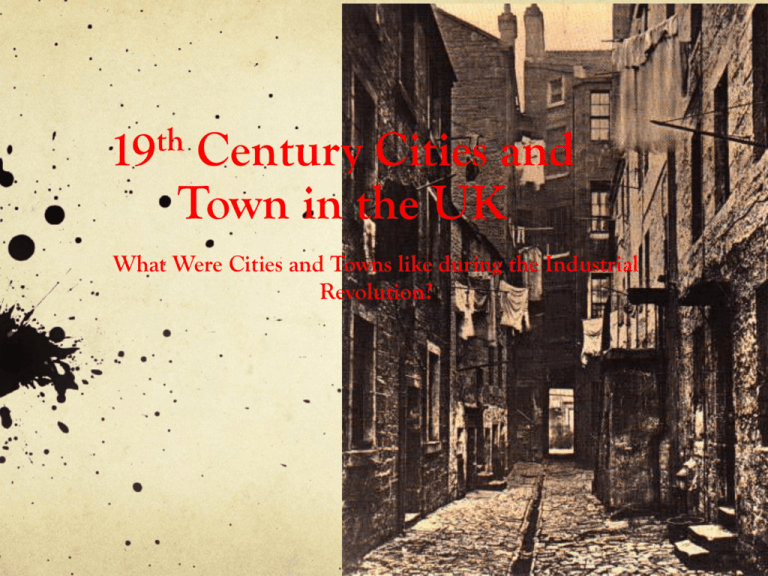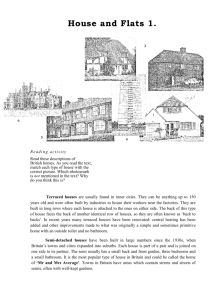19th Century Cities and Town in the UK
advertisement

19th Century Cities and Town in the UK What Were Cities and Towns like during the Industrial Revolution? Objective To understand the conditions of cities and towns in the 19th century. Starter In 1847, 40 people were found to be sharing a room in a house in Liverpool. True Night soil workers collected rubbish from the streets. False Most houses had inside toilets. False In Darlington people drank rainwater from a barrel containing a dead baby. True The average age that people lived to in Manchester during the Industrial Revolution was 17. True Introduction As enclosure and technical developments in farming had reduced the need for people to work on farmland, many people moved to the cities to get accommodation and a job. Furthermore, the advancement in the factory system had also displaced many people out of their traditional livelihood and lifestyle. As a result, the Industrial Revolution witnessed a huge growth in the size of British cities. In 1695, the population of Britain was estimated to be 5.5 million. By 1801, the year of the first census, it was 9.3 million and by 1841, 15.9 million. This represents a 60% growth rate in just 40 years. These cities, however, were not prepared for such an influx in such a short period of time! As a result, cities such as Birmingham, Liverpool, Manchester etc. (all vital to the Industrial Revolution) suffered problems not witnessed anywhere else in the world at this time. So what were these problems??? Use the next few slides of sources to fill in the following table in your exercise book: Life in 19th Century Towns TOILETS HOUSING REFUSE COLLECTION WATER & POLLUTION There was no rubbish collection so most towns had a dung heap that would grow and grow until it was eventually taken away. Children would play in it. Perhaps the worst type of accommodation for factory workers was a cellar. About 15,000 very poor people lived in cellars in Manchester in the 1840s. They were damp, cheerless and dark. Very little fresh air came into these cellars. People had flocked into these towns from the countryside. Towns seemed to offer guaranteed work and good wages; there was housing; there was work for the children. What more could a family want? It was difficult to keep the damp floors clean, especially since all their rubbish had to be carried upstairs to the street. Night soil workers were paid to carry away human sewage from the houses. They worked clearing dung from the worst parts of the towns but, because they were kept so busy, they would miss out many places. Here the manure collected was untouched. There were no indoor toilets in most of the houses and there was no running water inside either. The toilets and water tap were in a courtyard, which was shared by everyone around it. Children played here and people threw their rubbish in here, as well. In 1832 JP Kay, a local doctor, wrote a book about living conditions. Kay found that very many streets had piles of rubbish and human refuse in them. Many families shared a lavatory. In one town there were 33 lavatories for about 7000 people. Some houses had no lavatory at all. In another town, 500 families were without a toilet. Most of the sewage from these houses was either left in the street or thrown onto a dung heap in the courtyard or into a nearby river. A description of Jacob’s Island in London in 1874. We saw drains and sewers emptying their filthy contents into the river. We saw a whole row of privies (toilets without doors), used by men and women, built over it. We heard bucket after bucket of filth splash into it. Yet, as we stood gazing in horror, we saw a child lower a bucket into it to collect water from the river. The courtyard of a house often contained a large dung heap that might go on growing until a merchant bought it and carted it off. Sometimes, it was in an empty room in one of the houses instead. There were heaps of rags, bones, fish, rotten potatoes and other things lying in the street and in peoples’ houses. The stench was sickening. There was hardly any public transport so; houses were built close to the factories, often by the factory owners themselves. Most houses in the 19th century did not have an inside toilet. They used an earth closets instead. These earth-closets were supposed to be emptied regularly by ‘night-soil’ workers. Unfortunately, earth closets were not emptied regularly so the contents often overflowed. Land and houses cost money so the houses were built as cheaply as possible. Rows of terraces were built back to back. It saved space and materials. Houses were built as cheaply as possible. But after 1800 there just weren’t enough houses to cope with the increasing population. Presentation Task Prepare a script and radio broadcast 3-5 MINUTES highlighting the problems facing 19th century workers in Britain’s cities. TOILET HOUSING THE LIFE OF CHILDREN EDUCATION REFUSE COLLECTION WATER & POLLUTION VIOLENCE AND OTHER SOCIAL PROBLEMS ANYTHING ELSE YOU CONSIDER RELEVANT http://www.schoolshistory.org.uk/IndustrialRevolution/lifeduringindustrialrevolution.htm http://www.historylearningsite.co.uk/indrevo.htm http://www.bbc.co.uk/learningzone/clips/health-and-housing-in-the-19thcentury/11058.html Mark Scheme Level Description A* The student has presented the sources in excellent detail(s) and fully discussed the problems a 19th century city in Britain faced. A well structured presentation that uses a range of evidence from external sources (primary and secondary, including diagrams and pictures) displaying the conditions of a 19th century city in Britain. A The student has made a very good attempt to explain the sources and how it shows the problems a 19th century city in Britain faced. A structured presentation that uses key evidences from the sources to support most of the points made. B The student have begun to discuss the importance of the sources by providing a description of the problems a 19th century city in Britain faced. The student has provided some structure in the presentation and is able to use evidences from the sources to support the points they make; but they still need to develop their points more using explanation. C The students presentation lacks structure but does use limited evidence from the sources to support some points made. The student attributes limited references to the sources and does not fully address the problems a 19th century city in Britain faced.




